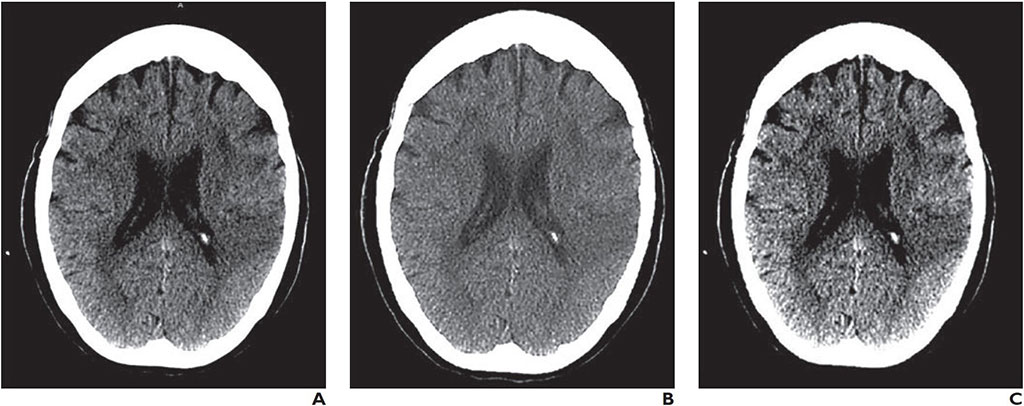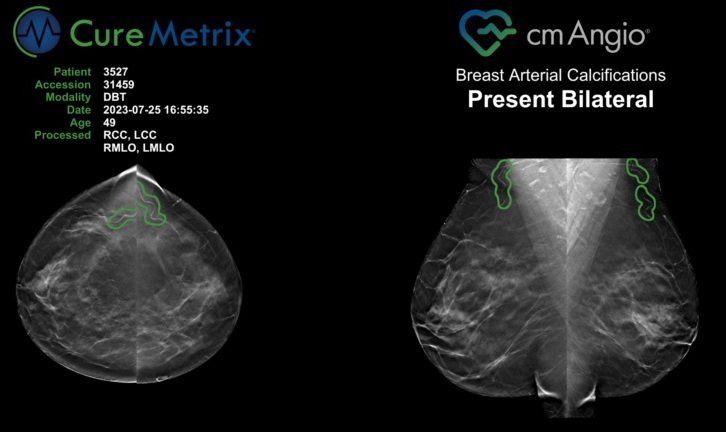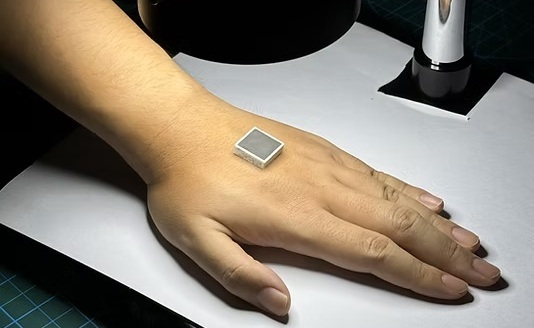Mobile Devices Prove Reliable for Acute Stroke Diagnosis
|
By MedImaging International staff writers Posted on 25 Feb 2020 |

Image: A CT image as seen on a Barco E-2620 monitor (A), Samsung Galaxy S8 Plus smartphone (B), and a Lenovo ThinkPad T460s laptop (C) (Photo courtesy of AJR)
A new study shows that interpretation of a computerized tomography (CT) scan on a smartphone or laptop is reliable prior to IV thrombolysis administration in acute stroke patients.
Researchers at the University of Los Andes (UniAndes; Bogotá, Colombia), Hospital Fundación Santa Fe de Bogotá (Colombia), and the Baptist Neurological Institute (Jacksonville, FL, USA) conducted a retrospective study of 2,256 CT interpretations to evaluate the reliability of head CT images displayed on smartphone or laptop reading systems in 880 patients with symptoms of acute stroke, compared with those made after interpretation of images displayed on a medical workstation monitor.
The CT interpretations on all three systems, conducted by four neuroradiologists, were then analyzed to calculate intra-observer and inter-observer agreements using the intraclass correlation coefficient (ICC) and interpretation variables that included hemorrhagic lesions; infarct size assessment; stroke dating (acute, subacute, and chronic); intraaxial neoplasm; and hyperdense arteries. In addition, accuracy equivalence tests were performed on recommendations for IV thrombolysis with recombinant tissue plasminogen activator (tPA).
The results showed that good or very good intra-observer agreements were shown for all the variables, and specifically for those variables required to establish contraindications for IV thrombolysis, where the agreements were ranked as very good. The tPA IV thrombolysis recommendation showed very good inter-observer agreements, with AUC values and sensitivities equivalent among all the reading systems at a 5% equivalent threshold. The study was published on January 28, 2020, in the American Journal of Roentgenology (AJR).
“Our study found that mobile devices are reliable and accurate to help stroke teams to decide whether to administer IV thrombolysis in patients with acute stroke,” concluded lead author Antonio Salazar, PhD, of the UniAndes Laboratory of Telemedicine and Electrophysiology, and colleagues. “These results constitute a strong foundation for the development of mobile-based telestroke services, because they increase neuroradiologist availability and the possibility of using reperfusion therapies in resource-limited countries.”
Mobile phone screen resolution has been significantly increased over the years, from the incipient QCIF (176 × 144 pixel) standard to the current Quad HD (2560 × 1440 pixel) or even Ultra HD (3840 × 2160 pixel) resolutions. At the same time, screen size has also been enlarged, from smaller than one inch to seven inches, or even larger. But the most important features for accurate medical grade images is the number of colors on grey scale images, contrast modulation, viewing angle, and calibration.
Related Links:
University of Los Andes
Hospital Fundación Santa Fe de Bogotá
Baptist Neurological Institute
Researchers at the University of Los Andes (UniAndes; Bogotá, Colombia), Hospital Fundación Santa Fe de Bogotá (Colombia), and the Baptist Neurological Institute (Jacksonville, FL, USA) conducted a retrospective study of 2,256 CT interpretations to evaluate the reliability of head CT images displayed on smartphone or laptop reading systems in 880 patients with symptoms of acute stroke, compared with those made after interpretation of images displayed on a medical workstation monitor.
The CT interpretations on all three systems, conducted by four neuroradiologists, were then analyzed to calculate intra-observer and inter-observer agreements using the intraclass correlation coefficient (ICC) and interpretation variables that included hemorrhagic lesions; infarct size assessment; stroke dating (acute, subacute, and chronic); intraaxial neoplasm; and hyperdense arteries. In addition, accuracy equivalence tests were performed on recommendations for IV thrombolysis with recombinant tissue plasminogen activator (tPA).
The results showed that good or very good intra-observer agreements were shown for all the variables, and specifically for those variables required to establish contraindications for IV thrombolysis, where the agreements were ranked as very good. The tPA IV thrombolysis recommendation showed very good inter-observer agreements, with AUC values and sensitivities equivalent among all the reading systems at a 5% equivalent threshold. The study was published on January 28, 2020, in the American Journal of Roentgenology (AJR).
“Our study found that mobile devices are reliable and accurate to help stroke teams to decide whether to administer IV thrombolysis in patients with acute stroke,” concluded lead author Antonio Salazar, PhD, of the UniAndes Laboratory of Telemedicine and Electrophysiology, and colleagues. “These results constitute a strong foundation for the development of mobile-based telestroke services, because they increase neuroradiologist availability and the possibility of using reperfusion therapies in resource-limited countries.”
Mobile phone screen resolution has been significantly increased over the years, from the incipient QCIF (176 × 144 pixel) standard to the current Quad HD (2560 × 1440 pixel) or even Ultra HD (3840 × 2160 pixel) resolutions. At the same time, screen size has also been enlarged, from smaller than one inch to seven inches, or even larger. But the most important features for accurate medical grade images is the number of colors on grey scale images, contrast modulation, viewing angle, and calibration.
Related Links:
University of Los Andes
Hospital Fundación Santa Fe de Bogotá
Baptist Neurological Institute
Latest General/Advanced Imaging News
- AI-Based Tool Accelerates Detection of Kidney Cancer
- New Algorithm Dramatically Speeds Up Stroke Detection Scans
- 3D Scanning Approach Enables Ultra-Precise Brain Surgery
- AI Tool Improves Medical Imaging Process by 90%
- New Ultrasmall, Light-Sensitive Nanoparticles Could Serve as Contrast Agents
- AI Algorithm Accurately Predicts Pancreatic Cancer Metastasis Using Routine CT Images
- Cutting-Edge Angio-CT Solution Offers New Therapeutic Possibilities
- Extending CT Imaging Detects Hidden Blood Clots in Stroke Patients
- Groundbreaking AI Model Accurately Segments Liver Tumors from CT Scans
- New CT-Based Indicator Helps Predict Life-Threatening Postpartum Bleeding Cases
- CT Colonography Beats Stool DNA Testing for Colon Cancer Screening
- First-Of-Its-Kind Wearable Device Offers Revolutionary Alternative to CT Scans
- AI-Based CT Scan Analysis Predicts Early-Stage Kidney Damage Due to Cancer Treatments
- CT-Based Deep Learning-Driven Tool to Enhance Liver Cancer Diagnosis
- AI-Powered Imaging System Improves Lung Cancer Diagnosis
- AI Model Significantly Enhances Low-Dose CT Capabilities
Channels
Radiography
view channel
Routine Mammograms Could Predict Future Cardiovascular Disease in Women
Mammograms are widely used to screen for breast cancer, but they may also contain overlooked clues about cardiovascular health. Calcium deposits in the arteries of the breast signal stiffening blood vessels,... Read more
AI Detects Early Signs of Aging from Chest X-Rays
Chronological age does not always reflect how fast the body is truly aging, and current biological age tests often rely on DNA-based markers that may miss early organ-level decline. Detecting subtle, age-related... Read moreMRI
view channel
Novel Imaging Approach to Improve Treatment for Spinal Cord Injuries
Vascular dysfunction in the spinal cord contributes to multiple neurological conditions, including traumatic injuries and degenerative cervical myelopathy, where reduced blood flow can lead to progressive... Read more
AI-Assisted Model Enhances MRI Heart Scans
A cardiac MRI can reveal critical information about the heart’s function and any abnormalities, but traditional scans take 30 to 90 minutes and often suffer from poor image quality due to patient movement.... Read more
AI Model Outperforms Doctors at Identifying Patients Most At-Risk of Cardiac Arrest
Hypertrophic cardiomyopathy is one of the most common inherited heart conditions and a leading cause of sudden cardiac death in young individuals and athletes. While many patients live normal lives, some... Read moreUltrasound
view channel
Wearable Ultrasound Imaging System to Enable Real-Time Disease Monitoring
Chronic conditions such as hypertension and heart failure require close monitoring, yet today’s ultrasound imaging is largely confined to hospitals and short, episodic scans. This reactive model limits... Read more
Ultrasound Technique Visualizes Deep Blood Vessels in 3D Without Contrast Agents
Producing clear 3D images of deep blood vessels has long been difficult without relying on contrast agents, CT scans, or MRI. Standard ultrasound typically provides only 2D cross-sections, limiting clinicians’... Read moreNuclear Medicine
view channel
PET Imaging of Inflammation Predicts Recovery and Guides Therapy After Heart Attack
Acute myocardial infarction can trigger lasting heart damage, yet clinicians still lack reliable tools to identify which patients will regain function and which may develop heart failure.... Read more
Radiotheranostic Approach Detects, Kills and Reprograms Aggressive Cancers
Aggressive cancers such as osteosarcoma and glioblastoma often resist standard therapies, thrive in hostile tumor environments, and recur despite surgery, radiation, or chemotherapy. These tumors also... Read more
New Imaging Solution Improves Survival for Patients with Recurring Prostate Cancer
Detecting recurrent prostate cancer remains one of the most difficult challenges in oncology, as standard imaging methods such as bone scans and CT scans often fail to accurately locate small or early-stage tumors.... Read moreImaging IT
view channel
New Google Cloud Medical Imaging Suite Makes Imaging Healthcare Data More Accessible
Medical imaging is a critical tool used to diagnose patients, and there are billions of medical images scanned globally each year. Imaging data accounts for about 90% of all healthcare data1 and, until... Read more
Global AI in Medical Diagnostics Market to Be Driven by Demand for Image Recognition in Radiology
The global artificial intelligence (AI) in medical diagnostics market is expanding with early disease detection being one of its key applications and image recognition becoming a compelling consumer proposition... Read moreIndustry News
view channel
GE HealthCare and NVIDIA Collaboration to Reimagine Diagnostic Imaging
GE HealthCare (Chicago, IL, USA) has entered into a collaboration with NVIDIA (Santa Clara, CA, USA), expanding the existing relationship between the two companies to focus on pioneering innovation in... Read more
Patient-Specific 3D-Printed Phantoms Transform CT Imaging
New research has highlighted how anatomically precise, patient-specific 3D-printed phantoms are proving to be scalable, cost-effective, and efficient tools in the development of new CT scan algorithms... Read more
Siemens and Sectra Collaborate on Enhancing Radiology Workflows
Siemens Healthineers (Forchheim, Germany) and Sectra (Linköping, Sweden) have entered into a collaboration aimed at enhancing radiologists' diagnostic capabilities and, in turn, improving patient care... Read more



















